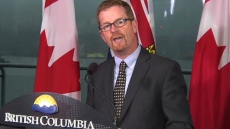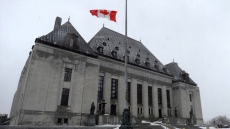HALIFAX — Pilots make the final call on whether it's safe to land a plane in bad weather, such as the conditions that prevailed early Sunday when an Air Canada passenger jet crashed at Halifax airport, aviation industry experts say.
Air Canada was adamant Sunday that the conditions were safe for the AC624 to land. Accident investigators later said it was too early to know if the weather played a role in the crash.
Pilots make a decision based on the information relayed to them by the tower, which includes runway conditions and other factors -- most importantly, whether the pilot can see the runway.
"The instruments will bring him to a certain altitude, then the pilot makes the decision, usually based on whether he can see the runway, whether to land," says Jonathan Bagg of Nav Canada, the country's air navigation service provider.
According to Bagg, there are many factors that enter into a pilot's decision to land.
Transport Canada is responsible for setting certain aviation guidelines, such as the minimum height at which an aircraft can approach the airport on an instrument approach. Once in landing range, the pilot decides if there is enough visibility for a safe landing.

"Transport Canada sets when pilots should be making a decision," Bagg said.
Bagg and Peter Spurway, a spokesman for Halifax Stanfield International Airport, say that the landing minimum is based on a number of factors, which can include the type of navigational equipment at the airport, the size of the plane and the weather.
Transport Canada did not immediately answer specific questions but the agency said in a statement that it was monitoring the situation in Halifax.
Spurway says the airport authority is responsible for maintaining the runway and advising the tower of conditions on the ground. They are responsible for snow clearing and providing friction tests, information which the tower passes on to the pilot.
Spurway says a number of weather conditions are factored in when a plane makes a decision to land. Visibility is most important, as is the speed and direction of the wind.
Larger aircraft, such as the Airbus passenger plane involved in Sunday's incident, are less susceptible to cross winds.
"If it was a small aircraft ... it wouldn't even have tried to land," he said.
The Halifax area was under a snowfall warning Saturday night and Air Canada's chief operating officer said wind speeds about 55 kilometres per hour.
Both Bagg and Spurway say that once all the information is relayed to the pilot, it is up to them to make a decision.
Bagg says a pilot may decide to divert to another airport or circle the runway until he or she feels it is safe to land, as the pilots of Air Canada flight 624 did.
"The pilot at the end of the day is the person flying the plane and he makes the decision," Bagg said.
The Transportation Safety Board said Sunday that the plane that crashed touched down some 335 metres short of a runway, hit an antenna array that ripped off its landing gear and skidded down the runway before coming to a stop.




